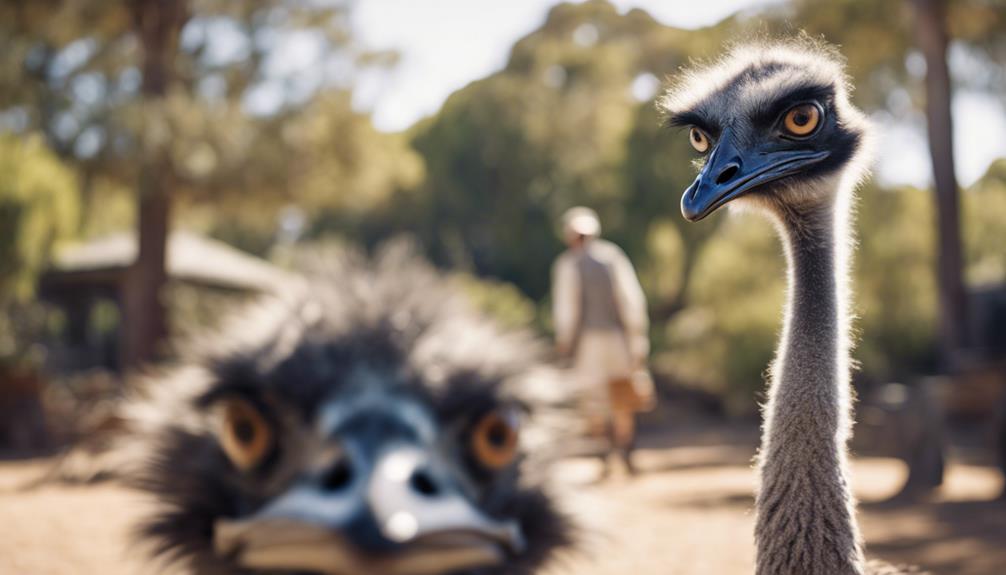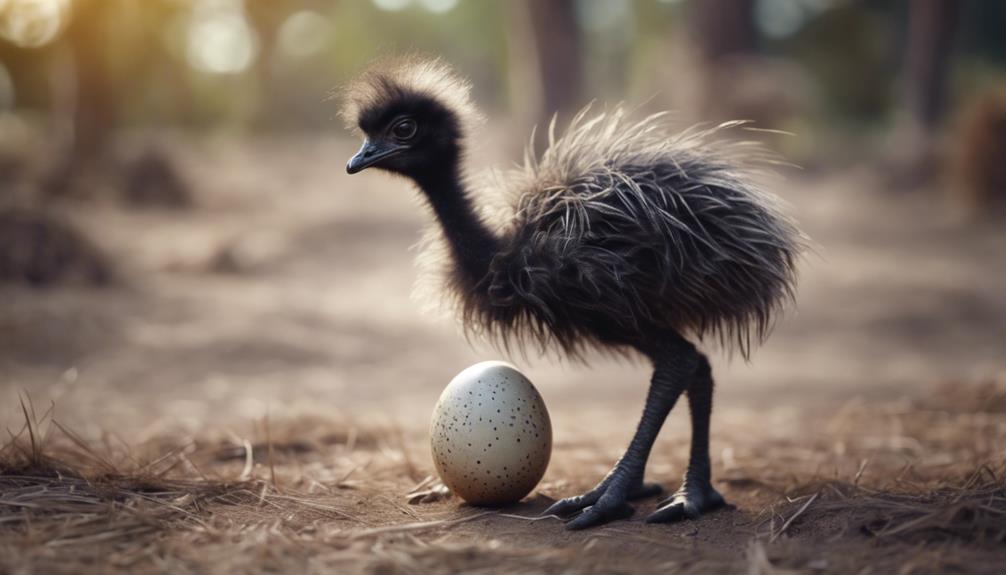
As you navigate through the intricacies of the emu's lifecycle, you'll discover a world of fascinating development and adaptation. From the delicate balance of egg incubation to the crucial stages of chick care, each phase plays a pivotal role in shaping the emu's journey. But what happens when these majestic creatures enter adulthood, carrying with them the culmination of all their earlier experiences? Stay tuned to uncover the final chapters of this captivating tale, where the emu's distinct characteristics truly shine.
Key Takeaways
- Male emu incubates eggs for 56 days.
- Fledglings rely on parents for guidance and protection.
- Emus reach 5 to 6.5 feet tall in adulthood.
- Nest preparation involves shared incubation duties.
- Parents teach vital skills like foraging and predator evasion.
Egg Development

During the incubation period, the emu egg undergoes intricate developmental stages, culminating in the formation of the embryo. The eggshell, a marvel of strength and porosity, serves as a protective barrier while allowing for gas exchange essential for the growing embryo. Inside, the yolk provides the necessary nutrients for the developing emu, while the amniotic membrane safeguards the embryo against external shocks.
As the days pass, the embryo's cells divide and differentiate, giving rise to the complex structures that will define the future emu chick. The circulatory system begins to form, ensuring the transport of oxygen and nutrients throughout the growing body. Simultaneously, the nervous system develops, laying the foundation for the emu's sensory and motor capabilities.
Hatching Process
The hatching process of an emu egg marks a critical juncture in the transition from embryo to chick, showcasing a remarkable display of nature's precision and complexity. As the incubation period nears its end, the chick inside begins to emit vocalizations, signaling its readiness to break free from the shell. Utilizing its egg tooth, a small calcified tip at the end of its beak, the emu chick meticulously pecks at the shell in a process known as pipping. This delicate procedure requires a balance of strength and finesse, as the chick must carefully chip away at the shell without causing harm to itself.
Gradually, the chick creates a fracture line around the egg, allowing it to push against the shell with its legs and emerge into the world. This momentous event is a testament to the resilience and instinctual behavior ingrained in emus. As the chick emerges, damp and exhausted, it begins its journey of growth and development under the watchful eye of its attentive parents.
Chick Care
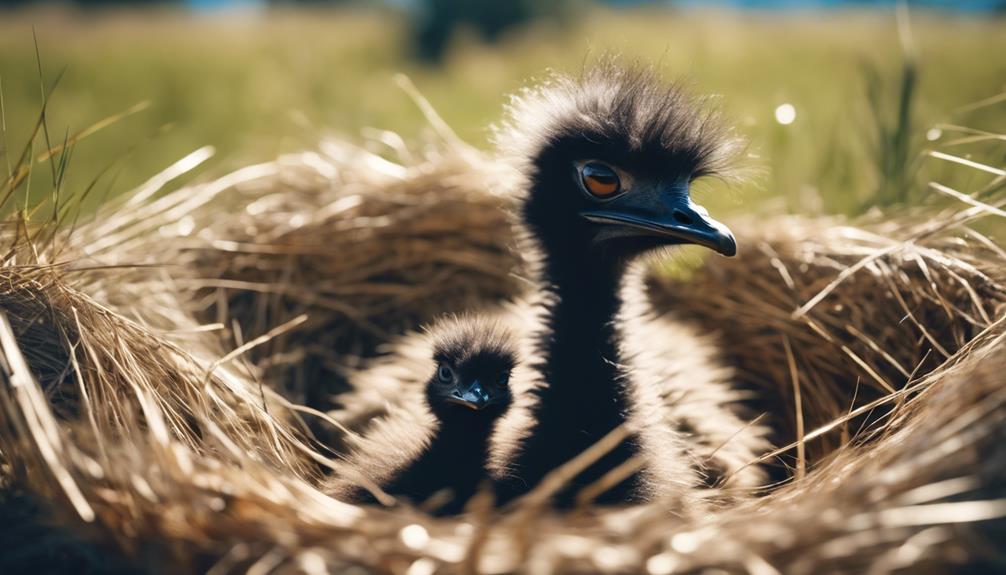
Ensuring optimal chick care post-hatching involves maintaining a controlled environment that supports their growth and well-being. Emu chicks are highly vulnerable during their early stages of life and require meticulous attention to thrive. Providing a warm and dry brooding area is essential, as these chicks are sensitive to temperature fluctuations. The brooding area should be equipped with a heat source to mimic the warmth they'd receive from their mother. Additionally, a clean and spacious living space is crucial for preventing diseases and ensuring proper development.
Feeding young emu chicks a balanced diet is vital for their growth. A diet rich in protein is necessary for their rapid development. Commercial emu starter feed or a specialized emu chick formula can provide the essential nutrients needed for their well-being. It's imperative to monitor their food intake to prevent overfeeding or underfeeding, as both can have detrimental effects on their health. Regular health check-ups and vaccinations are also recommended to ensure the chicks remain healthy and strong. By implementing these measures, you can promote the growth and vitality of emu chicks during their early stages of life.
Growth Spurts
As emu chicks progress through their development, they experience notable periods of rapid growth known as 'Growth Spurts.' These spurts are crucial for their overall development and physical maturation. During these growth spurts, you'll observe several key aspects:
- Increased Appetite: Emu chicks will display a voracious appetite during growth spurts, consuming larger quantities of food to support their rapid growth.
- Heightened Activity Levels: You'll notice a surge in their energy levels as they become more active during these periods, engaging in playful behaviors and exploration.
- Visible Physical Changes: The emu chicks will undergo noticeable physical changes such as a sudden increase in height, weight, and feather development.
- Molting: As part of their growth process, emu chicks may also experience molting during growth spurts, shedding old feathers to make way for new growth.
These growth spurts are essential for emu chicks to reach their full potential and prepare them for adulthood. By understanding and observing these periods of rapid growth, you can ensure the optimal development of your emu chicks.
Feeding Habits
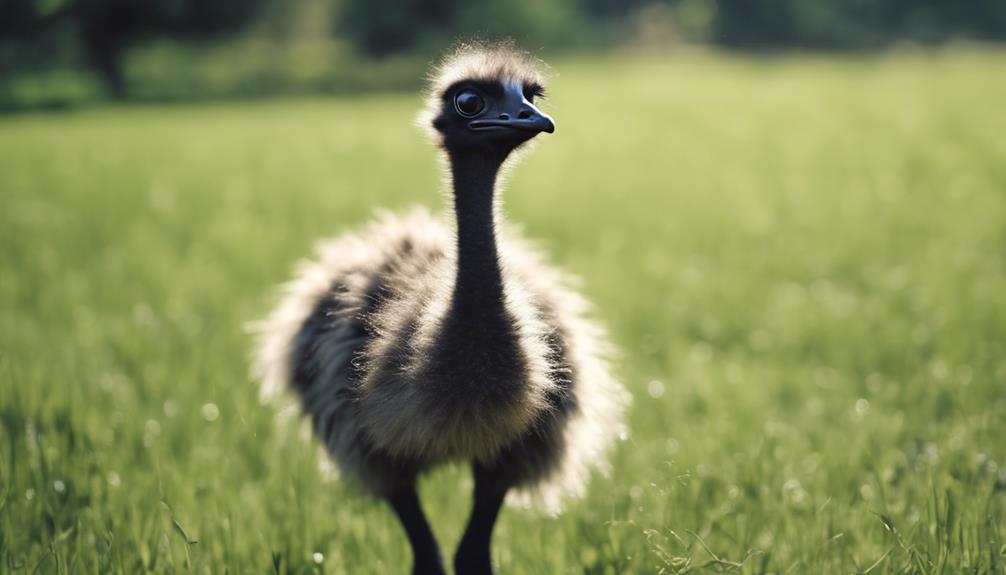
During their growth spurts, emu chicks exhibit a remarkable transformation in their feeding habits. Initially, these young emus rely heavily on a diet of insects, small plants, and the occasional pebble for digestion assistance. As they mature, their feeding habits evolve to include a more diverse range of foods, such as seeds, fruits, and even small vertebrates. Emu chicks demonstrate a voracious appetite during this stage, consuming large quantities of food to support their rapid growth.
Their feeding behavior becomes more assertive, with chicks actively foraging for food in their environment. They use their sharp beaks to probe the ground for insects or to pluck fruits from low-hanging branches. This phase is crucial for their development, as they must build up their strength and energy reserves to transition into adulthood successfully.
Adolescent Emus
As emu chicks enter adolescence, their physical characteristics and behavioral patterns undergo significant transformations. During this stage of development, adolescent emus exhibit the following notable features:
- Rapid Growth: Adolescent emus experience a rapid growth spurt, with their bodies increasing in size and their legs elongating to support their developing stature.
- Feather Development: Their fluffy down feathers are gradually replaced by adult-like feathers, which provide better insulation and protection.
- Increased Curiosity: Adolescent emus display a heightened sense of curiosity, often exploring their surroundings and interacting more with their environment.
- Social Interactions: They begin to engage in more complex social interactions with other emus, learning important hierarchical structures within their group.
These changes mark a crucial period in an emu's life as they transition from dependent chicks to independent juveniles, preparing them for the challenges they'll face as adults.
Mating Season
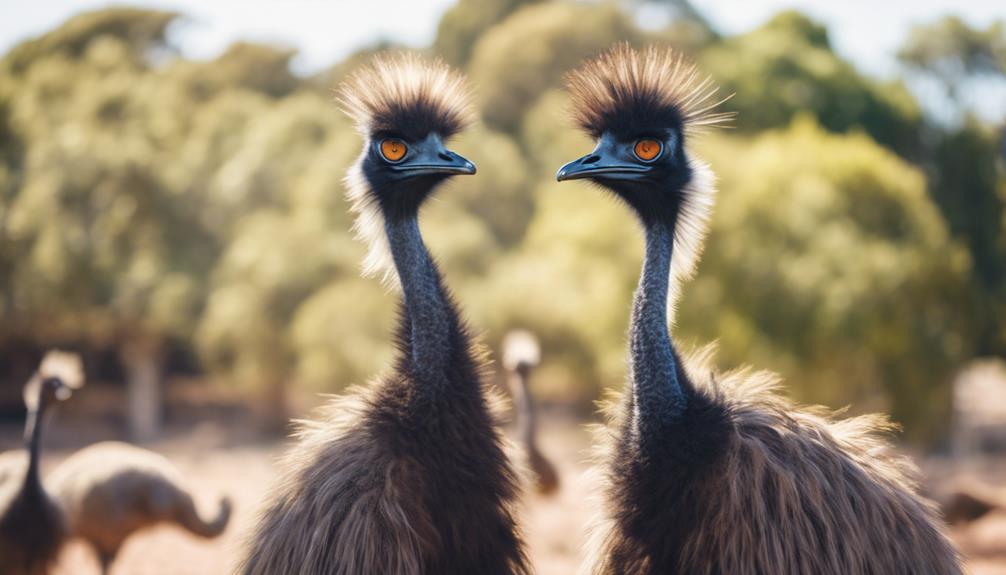
Entering the mating season, adult emus undergo physiological and behavioral changes in preparation for reproduction. During this period, male emus become more vocal and active in displaying their dominance to attract females. They puff up their chest, emit deep booming sounds, and perform a unique dance to court potential mates. On the other hand, female emus become more selective, observing male displays and choosing a suitable partner based on strength and vigor.
| Behaviors | Male Emus | Female Emus |
|---|---|---|
| Vocalization | Emit deep booming sounds to attract females | Listen and observe male displays for mate selection |
| Display | Perform a unique dance to court potential mates | Assess male displays to choose a suitable partner |
| Dominance | Puff up chest and show dominance traits | Select partners based on strength and vigor |
Nesting Behavior
Male and female emus exhibit distinct nesting behaviors as they prepare for the upcoming breeding season. The female emu takes the lead in the nesting process, while the male's role is primarily focused on guarding the nest site.
Here are some key behaviors observed during the nesting period:
- Nest Building: The female emu constructs the nest by scraping a shallow hole in the ground and lining it with leaves, grass, and other vegetation.
- Camouflaging the Nest: To protect the eggs from predators, the female covers the nest with sticks, leaves, and debris to camouflage it within the surrounding environment.
- Incubation Preparation: Once the nest is ready, the female lays a clutch of large, dark green eggs, typically between 8 to 10 eggs, and begins the incubation process.
- Shared Incubation: Unlike many bird species, emus share the responsibility of incubating the eggs. The male takes over the incubation duties while the female forages for food during this period.
These nesting behaviors play a crucial role in the reproductive success of emus, ensuring the survival of their offspring.
Incubation Period
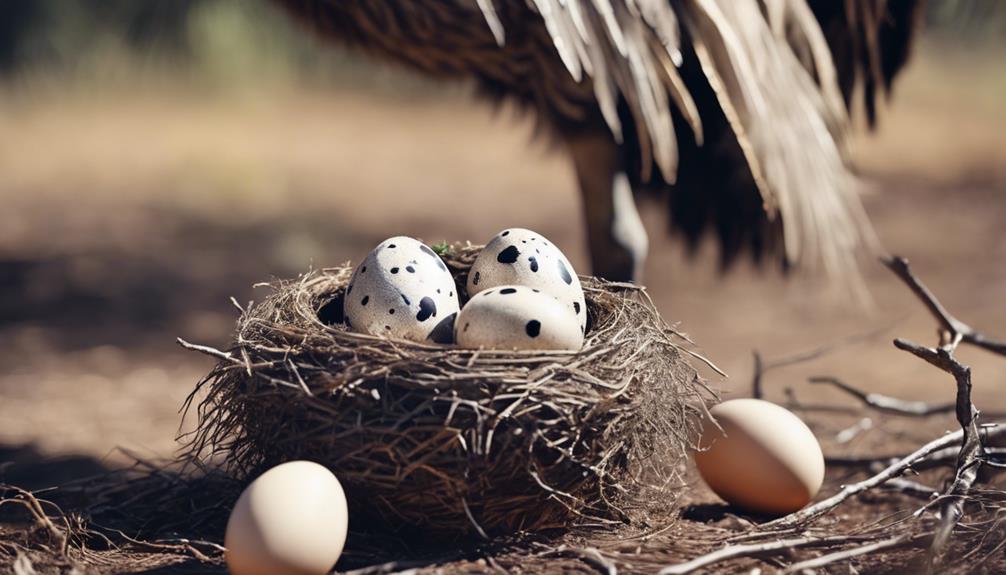
During the incubation period, emus demonstrate remarkable parental care and dedication in safeguarding their developing eggs. The male emu takes the primary role in incubation, sitting on the eggs for around 56 days while the female roams and only returns occasionally to check on the nest. This behavior is crucial for the survival of the offspring, as the eggs need to be kept at a constant temperature for proper development. Emus are known for their attentiveness during this period, rarely leaving the nest and turning the eggs regularly to ensure uniform heat distribution. Their dedication to the incubation process is a testament to their evolutionary adaptability and commitment to their offspring's well-being.
| Egg Rotation | Constant Temperature | Nest Maintenance |
|---|---|---|
| Regularly turn the eggs to ensure even heat distribution | Maintain a stable temperature by adjusting body position | Keep the nest clean and secure from predators |
Parental Duties
In the realm of emu biology, the responsibilities of parental care encompass a range of essential tasks crucial for the survival and development of the offspring. Emu parents exhibit remarkable dedication in nurturing their young, ensuring their well-being through various actions:
- Incubation: Emu fathers take charge of incubating the eggs, showing a rare reversal of roles in the avian world.
- Protection: Both parents fiercely guard the nest from potential threats, displaying a strong sense of territoriality.
- Feeding: Once the chicks hatch, the parents diligently provide them with a diet rich in proteins and nutrients to support their growth.
- Education: Emu parents actively engage in teaching their offspring essential skills such as foraging, social interactions, and predator avoidance strategies.
These parental duties are crucial in shaping the survival and success of the young emus, highlighting the intricate balance of nature's design in ensuring the continuity of this majestic species.
Fledgling Stage

Upon hatching from their eggs, emu chicks enter the fledgling stage marked by rapid growth and the development of crucial survival skills. During this stage, emu chicks are covered in soft, light brown feathers that aid in camouflaging them from predators in their natural habitat. They rely on their parents for protection and guidance as they begin to explore their surroundings and learn essential behaviors such as foraging for food and recognizing danger.
As fledglings, emu chicks exhibit a remarkable rate of growth, quickly gaining strength in their legs to keep pace with their inquisitive nature. They engage in playful behaviors that help them hone their coordination and agility, essential skills for evading threats in the wild. Additionally, they start to experiment with vocalizations, practicing different calls that will become crucial for communication within the emu community.
Adulthood Characteristics
As emu chicks mature into adulthood, their physical appearance undergoes significant changes, reflecting their transition to independence and establishment within the emu community. During this stage, you'll notice the following characteristics:
- Height: Emus reach their full height, standing at around 5 to 6.5 feet tall, making them one of the largest bird species in the world.
- Coloration: Their feathers transition to a darker shade, primarily brownish-black, providing better camouflage in their natural habitat.
- Musculature: Adult emus develop strong leg muscles that enable them to run at impressive speeds, reaching up to 30 miles per hour.
- Demeanor: With maturity comes a more assertive and confident demeanor, as adult emus establish their place within the social hierarchy of the group.
Emu adults embody power and resilience, adapting to their environment with remarkable physical attributes that set them apart in the animal kingdom.
Frequently Asked Questions
Can Emus Fly Like Other Birds?
Emus cannot fly like other birds due to their large, heavy bodies and small wings. They have evolved for running, utilizing their strong legs to reach speeds up to 30 mph rather than taking to the skies.
How Do Emus Communicate With Each Other?
Emus communicate vocally through deep booming sounds and grunts, often to establish territory or attract a mate. They also use body language, such as head bobbing and feather fluffing, to convey messages to one another.
What Predators Do Emus Have in the Wild?
In the wild, emus face predators such as dingoes, wedge-tailed eagles, and feral pigs. These predators pose threats to emus at different stages of their lifecycle, requiring the birds to be vigilant and adaptive.
Do Emus Migrate to Different Areas?
Emus do not migrate to different areas. Their habitat is often stable, and they are known for their ability to adapt to various environments within their established territory. Emus are territorial birds.
How Long Do Emus Typically Live in the Wild?
In the wild, emus typically live around 10 to 20 years. Factors like predators, diseases, and environmental conditions can impact their lifespan. Emus exhibit resilience and adaptability, showcasing their evolutionary prowess in survival.
Conclusion
As you witness the lifecycle of an emu, from egg development to adulthood characteristics, you observe the intricate process of growth and development.
From the crucial incubation period to the fledgling stage, each phase plays a vital role in shaping the emu into a strong and confident bird.
By understanding the behaviors and needs of these fascinating creatures, we gain insight into the wonders of nature's intricate design.


